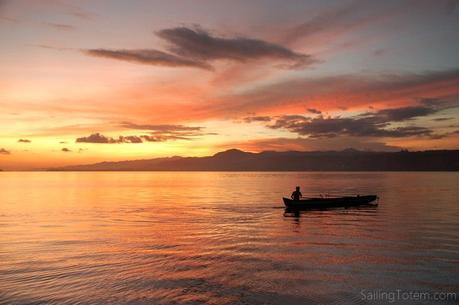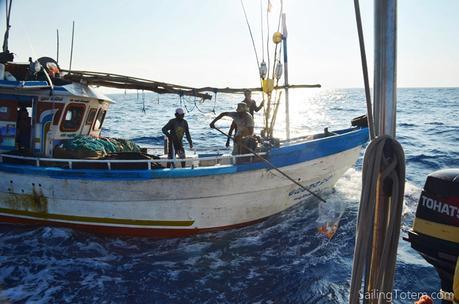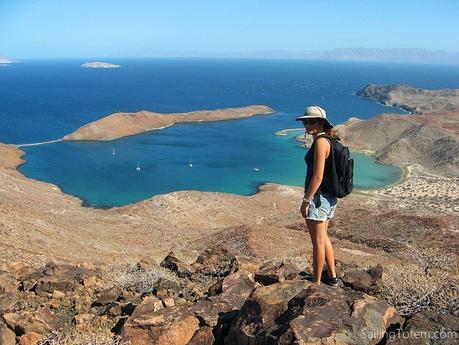
“What kind of guns do you have on board?” This was the opening question from a new acquaintance at a cocktail party. Loaded with assumptions from someone who doesn’t know us, and who has no intention of traveling the way we do. Walking down the dock the other day, a woman was overheard talking about practicing at the range because they were going to Mexico, and she’d need her gun there. It’s a big scary world out there, gotta protect yourself!
Or…it isn’t, and you just have to ditch the paranoia and think about it a little. The reality of our personal safety risks as cruisers is out of scale with those perceptions. But I guess in the “if it bleeds, it leads” media, a lot of people are lead to believe that the world outside the US borders is a dangerous place. It’s just not right. With only a couple of exceptions, I’ve felt safer outside the USA during our years of travels than I do back at home. The scariest moment in our eight years of cruising came in California and had nothing to do with malicious intent…but that’s another story. What I wish the guy at the cocktail party had asked is “how do you stay safe?” This is something we think about all the time! Besides a healthy appreciation for our own lives, we carry our most precious cargo on board – our three kids. Any impression that we are cavalier about safety is misplaced.
Piracy hotspots are well known and easy to avoid. Our encounters at sea are so minimal they’re almost not worth mentioning. We were scouted in the South China Sea, a definite hotspot, but only for commercial vessels. There was a fishing boat in Sri Lanka that followed us for an entire day. We know it was a bunch of fishermen, and MAYBE it could have spun into something more than that, but that’s pure speculation. When the sun got low and they were still tailing us, we radioed our buddy boat and they basically beelined to our position… the fishermen left. (FWIW, these same guys traded us gorgeous fish!)

Just countries get an unwarranted bad reputation; others simply need to be understood as more complex than just “bad” in general. O on couple of times we’ve chosen to travel in places that were so-called “dangerous” after our research concluded we’d be able to visit with minimal security risks. Papua New Guinea is one of those countries with a terrible reputation. It can be dangerous and has some crazy violent crime, just like the USA. But with a little bit of research, and understanding both where and why crime occurs, we made a plan to avoid problems and spent an unforgettable three months with few concerns. We had basic rules: we mapped locations with positive first-hand reports (I wrote about it here), we avoided places that were trouble hotspots (unique dynamics to PNG with extraction industries for mineral/timber/fish, or population centers), and we always trusted our gut: if a place didn’t feel right, we moved on.
Mexico is a more familiar for most Americans, like the woman down the dock who thought she’d need to arm herself. I chalk this up to lack of understanding and media influence. Staying safe in Mexico mostly comes down to “don’t be stupid” (walk around Tijuana drunk at 2am? Involved in drug trade of any kind?). We paid attention to the coconut telegraph and local reputations (watch your dinghy in Mazatlán, and your outboard in Barra.). Pretty sure most cruisers who have been to Mexico would agree with me: we feel safer there than we do in the US by a wide margin!

Petty theft happens. If you think disguising your outboard to look beat up and old will make it less appealing, think again. It’s an outboard. Our US flag was probably stolen off the back of the boat in Seychelles, but we’re not even positive that was deliberate vs slippery line and knots coming undone. Our horseshoe was taken off the back of the boat in Labuan, Malaysia…probably. I think it was secure? Know the reputation of places you go, what to do or not do, and then be open. We’ve also noticed that folks who assume people are out to get them until proven otherwise are more likely to have problems with petty theft. There’s no statistical significance to the observation, but something demonstrated often enough.
With a return to the Caribbean ahead, we have a lot to learn about staying safe. Once again, it’s an area with risks to learn about and decide how to approach. Should we put bars across the hatches? Are there destinations to rule out? There’s a lot to figure out, but we’ll do our best, and we sure don’t think we’re safer by staying at home.
Back to the question we had at that cocktail party about how many guns are on Totem. Diplomatic me wants to say that guns on board are a personal choice and your choice is fine, but I’m not feeling very diplomatic. Guns aboard are a bad idea for a pile or reasons. Had the German boat recently boarded in the Philippines not had guns aboard, the woman aboard would probably still be alive. So would Sir Peter Blake.
While cruising in Mexico, we met a former green beret colonel out cruising with his family. His training is extensive, and his opinion- which I respect- was that the training needed for a gun on board is WAY outside the realm of the typical cruiser. It’s not just about going to the range, and how to handle it, but the microdecisions about when to use it. Even with all of his training, he felt he was safer without a gun on board than with one.
Aside from the fact that the best way to be shot by a gun aboard is to have a gun aboard, it’s a hassle. You have to declare them on entry in a new country. That country will almost certainly take them for you until you clear out, and your port of entry and intended port of clearance could be a long distance apart. Lying and hiding guns? Laws vary of course, but can mean incarceration or death if they’re found! Go ahead, cowboy. If someone is determined to target us and to take our stuff, I’d rather just let them take it than risk greater personal injury to my kids or myself.

